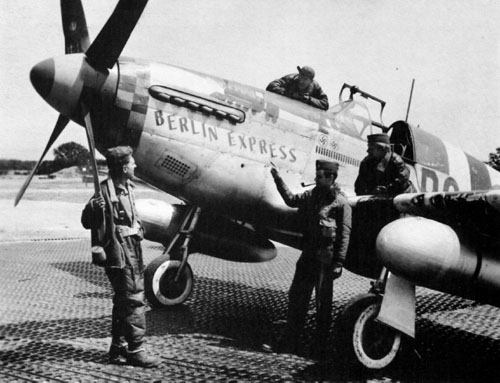
How many of you have been to La Tour Eiffel (Eiffel Tower) in Paris? It’s one of those icons that anyone going to Paris must visit. But like Mount Rushmore and the Grand Canyon, your next reaction is “seen it, done it, let’s move on” (no disrespect is intended). Although the nightly light show is pretty cool so it might warrant a second visit.
Before we get to the meat of today’s blog topic, let’s look at some interesting facts about the Eiffel Tower.
The Eiffel Tower
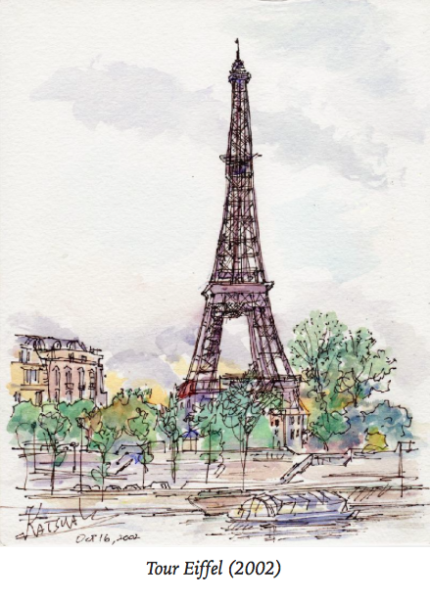
Built by Gustave Eiffel for the Paris Exposition Universelle in 1889 (exactly 100 years after the French Revolution), the tower met with immediate distain (there were some rather colorful comparisons used—you can use your imagination). Today, more than a century later, the Eiffel Tower remains the most iconic symbol of Paris. Watch the building of the Eiffel Tower.
Here are some fun facts about the tower: Total Height: 324 meters (1,063 feet)
Height to 3rd Floor: 276 meters (905 feet)
Height to 2nd Floor: 115 meters (377 feet)
And important to our story, the height to the 1st floor: 57 meters (187 feet)
Five lifts (elevators) travelling each year a total of 103,000 kilometers or 64,000 miles or a little more than 2.5 times the circumference of the earth.
You want some exercise? Then there are 1,665 steps to the top.
20,000 light bulbs illuminate the tower each night for five minutes on the hour between nightfall and 1:00 AM.
60 tons of paint are needed to repaint the tower every seven years.
120 antennas are positioned on the tower.
Approximately 7.0 million visitors each year; 90% are international tourists.
And finally, the tower weighs 10,100 tons; metal accounts for 7,300 tons.
Gustave Eiffel
Gustave Eiffel (1832–1923) was a French engineer and architect. His contributions to many widely recognized structures besides the Eiffel Tower are numerous. He was responsible for designing and constructing bridges, large municipal railroad stations, cathedrals, viaducts, astronomical domes, and finally, the design of the Panama Canal locks (although his designs were not used once the Americans took over responsibility for building the canal).
Eiffel’s engineering specialty and reputation were built on his expertise on structural issues. The man given the task of designing and building the Statue of Liberty, Frédéric Auguste Bartholdi (1834–1904), hired Eiffel in 1880 to design the interior structure of the statue he called Liberty Enlightening the World. The rest is history.
World War II
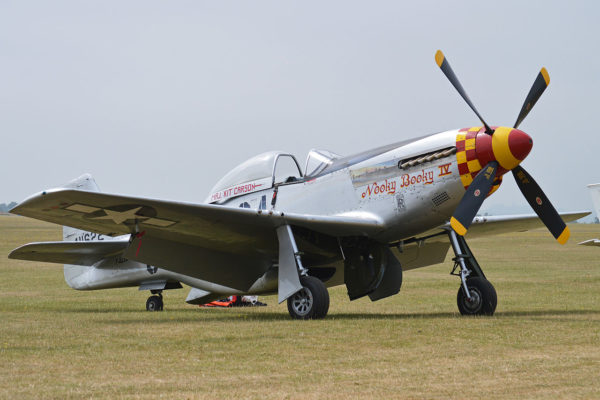
The Eiffel Tower was shut down during the four years of the German occupation. The man in charge of the tower had French partisans disable the lifts. He wanted any German tourist/soldier to have to walk up the 1,665 steps. During the time of the Liberation, the Allies operated their radio transmitters from the second floor. By 1945 the lifts were put back into operation and Allied soldiers were allowed to ascend the tower at no charge.
The same man, fire chief Lucien Saringuet who took down the French flag from the tower on 14 June 1944 (Occupation Day), attempted to replace the Nazi flag with the French flag on 25 August 1944 (Liberation Day). Due to heavy shooting by German soldiers at the base of the tower, Saringuet was unsuccessful with that attempt.
Hunting Down the French Resistance
Now to our story.
By 1944, the Nazis had overrun the former unoccupied territory, reached the zenith of their barbaric atrocities, and were hunting down Résistants (French Resistance members) and members of the rural guerilla resistance movement called the Maquis (the maquisards—the scrubby underbush). The Germans employed the French Gestapo (click here to read The French Gestapo), the Milice (a paramilitary French organization of fascists), and other collabo Frenchmen to assist them in tracking, arresting, and executing members of the Resistance as well as foreign agents (click here to read Women Agents of the SOE).
The French Resistance spirits were low. That is until William Overstreet Jr. came along in his P-51 named the Berlin Express.
William Overstreet Jr.
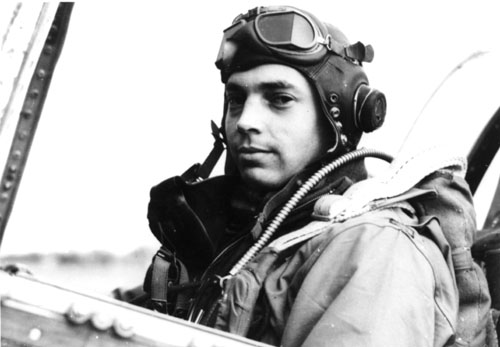
William “Bill” Overstreet Jr. (1921–2014) enlisted in the Army Air Corps (click here to read Killed in the Service of Her Country) shortly after Pearl Harbor was attacked on 7 December 1941.
He did his pre-flight training in Santa Ana, California and then on to Tulare, California for actual flight training. By 1943, Bill had been assigned to the 357th Fighter Group of the 363rd Fighter Squadron. After flying P-39s and P-47s, Bill was assigned to fly the P-51s. His first P-51 was named the Southern Belle, but it was lost in combat by another pilot. By this time (1944), squadrons of P-51s were flying attack missions over Germany and Berlin—Bill’s next P-51 was named Berlin Express.
After Bill’s flight under the Eiffel Tower, he went on to participate in D-Day sorties, flying secret missions, and chalking up a “kill” of a German ME109 fighter over Poland without any bullets on board—Russian vodka was stored in the ammunition bays.
The Dogfight
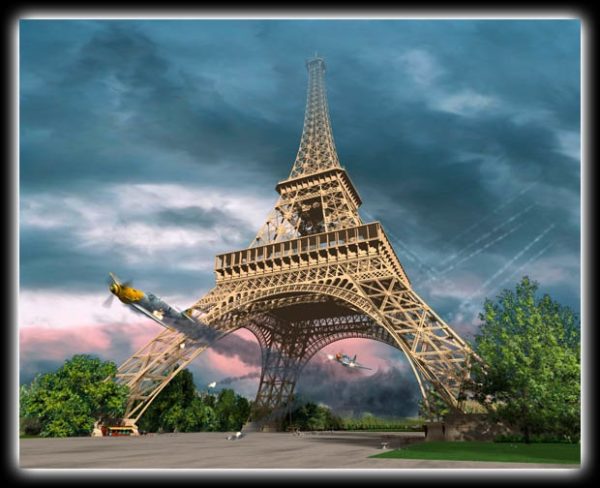
One day during spring 1944, Bill and his P-51 engaged in the attack of a ME109 fighter over the city of Paris. Despite heavy enemy flak over the city, Bill got behind the German plane and sent off a round of bullets. The German’s engine was hit and in an effort to evade Bill, the German pilot flew underneath the Eiffel Tower. Remember, the height from ground level to the first floor is only 187 feet (and the widest span is at ground level).
Well, Bill followed the ME109 through and under the first floor of the tower (as depicted in the painting by Len Krenzler). The German plane crashed and Bill was able to escape by flying low and following the Seine until he was far enough away from Paris and the flak.
The dogfight was witnessed by hundreds of people including future French dignitaries. After liberation, they commented that Bill’s act of bravery and skill had the effect of uplifting the morale of the Resistance and Parisians—six months after Bill’s visit to Paris, the city would be free.
The Aftermath
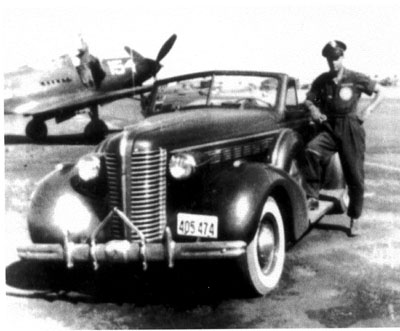
Like most of the returning veterans, Bill got back to a normal life by resuming his college education, launching a career (as an accountant), and marrying and raising a family.
Like so many World War II veterans, Bill never talked about his wartime service. It wasn’t until later in life that his story was discovered and began to be told. By 2009, the French decided to award Bill with their Legion of Honor. His wartime comments always centered on the theme of teamwork and accomplishments of others.
Bill passed away at the age of 92 in 2014.
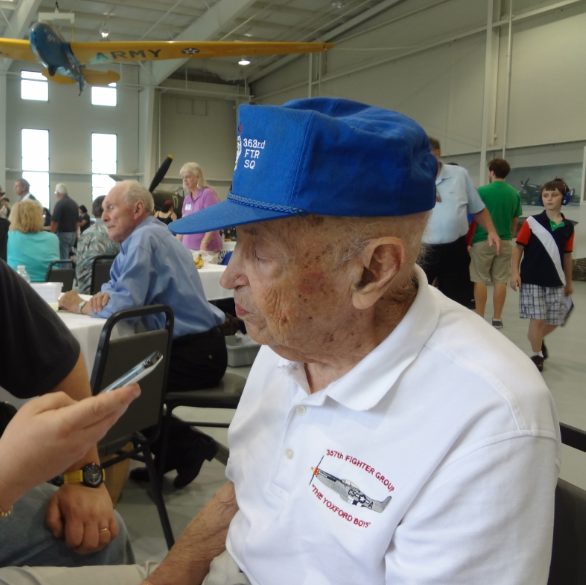
Acknowledgement
There are two acknowledgements I’d like to address.
The first is to the Warbirds News (www.warbirdsnews.com). This is an organization that is very comprehensive in its tracking, reporting, and information regarding the United States history of military aviation. Thanks to them for several of the images displayed in this blog.
The second thank you goes to Angelo Nicholas, curator and owner of the Art Country Canada art gallery (www.artcountrycanada.com). He was gracious enough to allow me to use the image of Mr. Krenzler’s painting, The Berlin Express Arrives in Paris.
Someone Is Commenting On Our Blogs
Thanks to Pal N. who brought this story to my attention. We were over at our friend Neil A.’s house one night drinking some fine bourbon when Pal talked about this story. Frankly, I didn’t believe him. But you know, one thing I’ve learned is that there are thousands of stories like these—it’s just a matter of finding them. So thanks to Pal for sending the article to me and setting me off on many hours of research.
If there is a topic you’d like to see a blog written about, please don’t hesitate to contact me. I love hearing from you so keep those comments coming.
What’s New With Sandy and Stew?
Again, if you have read any of the walking tour books (in whole or part), we would very much appreciate you writing a brief review on Amazon. It seems books move up the Amazon hierarchy ladder based on the number of reviews. Thanks for taking a couple of minutes to do that for us.
Why Would You Want To Buy Our “Walks Through History” Books?
Simple.
You like to travel and experience history and historical events. You like to see original buildings that had a significant impact on the people and events of the history you’re engaged with. You want to know the stories behind the brick and mortar in front of you.
The walking tour books are meticulously researched so you can go directly to those sites and learn about the building’s history as well as an introduction to some of the more interesting people associated with it.
Thank You
Sandy and I appreciate you visiting with us. We have some exciting things on the horizon and we’ll keep you updated as we go along.
Share This:
Follow Stew:
Find Stew’s books on Amazon and iBooks.
Please note that we do not and will not take compensation from individuals or companies mentioned or promoted in the blogs. Walks Through History
Walks Through History
Copyright © 2017 Stew Ross


Hey there Stew! Just finished reading your article about the dogfight under the Eiffel Tower, and I couldn’t help but drop a comment to express my excitement. First of all, I have to say your storytelling skills are top-notch. You really brought that dramatic dogfight to life, and I felt like I was right there under the Eiffel Tower, witnessing it all. Your vivid descriptions and attention to detail painted such a clear picture. It’s like I was watching a thrilling action movie in my mind!
I also appreciate the historical context you provided; it made the whole story even more fascinating. The blend of aviation history and the iconic Eiffel Tower backdrop was a unique and intriguing combination. I never knew such an event had taken place, and your article not only educated me but left me craving more. I’ll definitely be looking forward to more of your articles. Keep up the fantastic work, Stew!
Thank you Tourstravelfinder for contacting us. Your kind comments are very much appreciated. I hope we can continue to meet and exceed your expectations with our future bi-weekly blogs. STEW